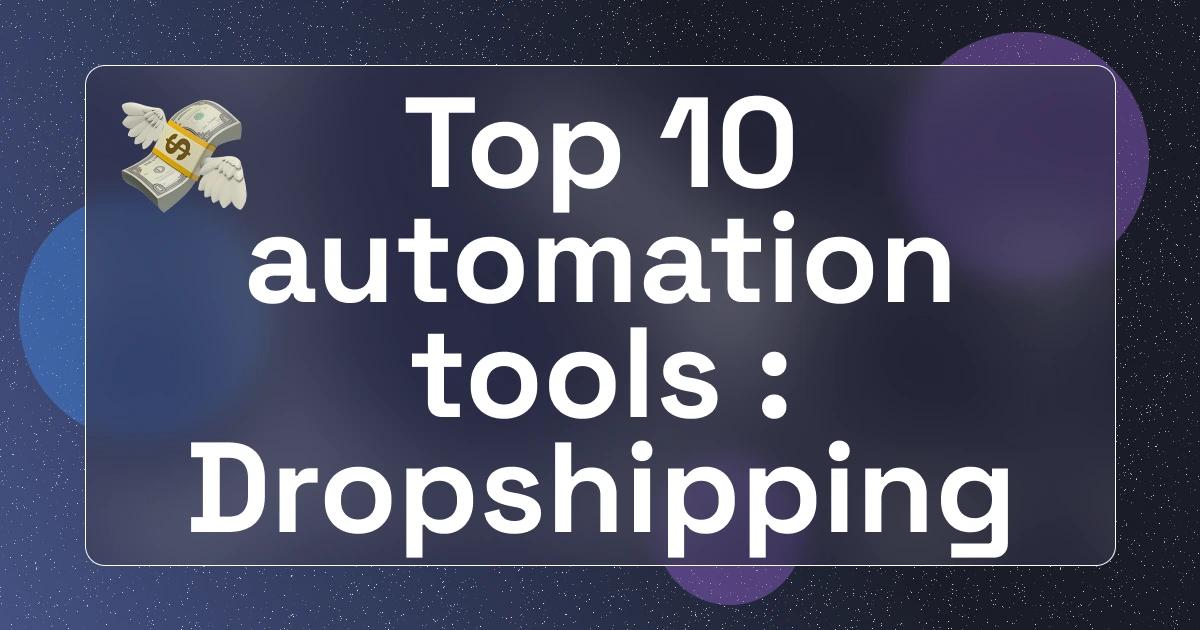
Top 10 automation tools for dropshipping : Boost your e-commerce efficiency and sales
Dropshipping has revolutionized the e-commerce landscape, offering entrepreneurs a low-risk way to start an online business. However, managing a dropshipping store can be time-consuming and complex. That's where automation tools come in, streamlining operations and boosting efficiency. Let's explore the world of dropshipping automation and discover how these powerful tools can transform your business.
Understanding dropshipping automation software
Dropshipping automation software is designed to simplify and streamline various aspects of running an online store. These tools handle tasks such as inventory management, order processing, and product research, allowing entrepreneurs to focus on growing their business.
The primary goal of automation tools is to reduce manual workload and minimize errors. By automating repetitive tasks, business owners can save time and ensure more accurate operations. This efficiency boost can lead to improved customer satisfaction and increased sales.
Key features of dropshipping automation software include:
- Product research and importing capabilities
- Real-time inventory management
- Automated order processing and fulfillment
- Integration with multiple e-commerce platforms
- Price and stock monitoring
- Customer service automation tools
These features work together to create a seamless dropshipping experience, enabling entrepreneurs to manage their stores more effectively and scale their businesses with ease.
Benefits of implementing automation in your dropshipping business
Integrating automation tools into your dropshipping workflow can transform your business operations and drive growth. Here are some key benefits of using dropshipping automation software:
1. Time-saving: By automating repetitive tasks, you can free up valuable time to focus on strategic aspects of your business, such as marketing and customer engagement.
2. Reduced errors: Automation minimizes the risk of human errors in order processing, inventory management, and product listings, ensuring a smoother operation.
3. Improved inventory management: Real-time stock updates and automated reordering help prevent overselling and stockouts, maintaining a balanced inventory across multiple suppliers.
4. Streamlined product research: Many automation tools offer features to help you identify trending products and import them directly to your store, simplifying the product selection process.
5. Enhanced customer experience: Faster order processing and accurate inventory information lead to improved customer satisfaction and fewer issues with out-of-stock items.
By leveraging these benefits, dropshipping entrepreneurs can scale their businesses more efficiently and compete effectively in the e-commerce marketplace.
Selecting the right automation tools for your dropshipping venture
Choosing the best automation tools for your dropshipping business requires careful consideration of various factors. Here's a guide to help you make an informed decision:
1. Platform compatibility: Ensure the tool integrates seamlessly with your chosen e-commerce platform. Most automation software supports popular platforms like Shopify, while others may specialize in specific systems like WooCommerce or WordPress.
2. Supplier networks: Consider tools that provide access to reliable supplier networks. Some offer connections to US and European suppliers for faster shipping times, while others focus on global marketplaces like AliExpress.
3. Pricing structure: Evaluate the cost-effectiveness of different tools based on your business size and needs. Many offer free basic plans or trials, with paid plans ranging from $20 to $150+ per month. Some charge based on order volume or product count.
4. Additional features: Look for tools that offer valuable extras such as product customization options, branded invoicing, supplier communication tools, and performance analytics.
5. Ease of use: Consider the learning curve associated with each tool. User-friendly interfaces and comprehensive support can make a significant difference in your ability to leverage the software effectively.
To help you compare different options, here's a table highlighting some popular dropshipping automation tools:
| Tool | Key Features | Platform Compatibility | Pricing (Starting from) |
|---|---|---|---|
| DSers | Bulk order processing, AliExpress integration | Shopify, WooCommerce | Free (basic plan) |
| AutoDS | All-inclusive solution, product research | Multiple platforms | $19.90/month |
| Dropified | Multi-website imports, auto-order placement | Shopify, WooCommerce, CommerceHQ | $47/month |
| Spocket | US/EU suppliers, faster shipping | Shopify, WooCommerce, Wix | $24/month |
| Inventory Source | 230+ pre-integrated suppliers | 25+ e-commerce platforms | $99/month |
Remember, the best tool for your business depends on your specific needs, budget, and long-term goals. It's often beneficial to take advantage of free trials to test different options before committing to a paid plan.
Maximizing the potential of dropshipping automation
To truly harness the power of automation in your dropshipping business, it's essential to implement best practices and strategies. Here are some tips to help you maximize the potential of your chosen automation tools:
1. Integrate multiple tools: While all-in-one solutions can be convenient, sometimes combining specialized tools can provide a more robust automation setup. For example, you might use one tool for product research and another for order fulfillment.
2. Regularly update product information: Use automation to keep your product listings up-to-date with the latest prices, descriptions, and stock levels. This ensures accuracy and helps maintain customer trust.
3. Leverage analytics: Many automation tools offer analytics features. Use this data to identify trends, optimize your product selection, and make informed decisions about your business strategy.
4. Automate customer communication: Set up automated email sequences for order confirmations, shipping updates, and follow-ups. This improves the customer experience without requiring constant manual intervention.
5. Test and optimize: Continuously evaluate the performance of your automation setup. A/B test different strategies and refine your processes to achieve the best results.
By following these strategies, you can create a highly efficient dropshipping operation that scales seamlessly as your business grows. Remember, automation is a powerful tool, but it should complement rather than replace human oversight and decision-making.
In conclusion, dropshipping automation tools offer a wealth of opportunities for e-commerce entrepreneurs. By carefully selecting and implementing the right tools, you can streamline your operations, reduce errors, and focus on strategic growth. As the e-commerce landscape continues to evolve, embracing automation will be key to staying competitive and building a successful dropshipping business.
Frequently Asked Questions (FAQ)
Share on social
